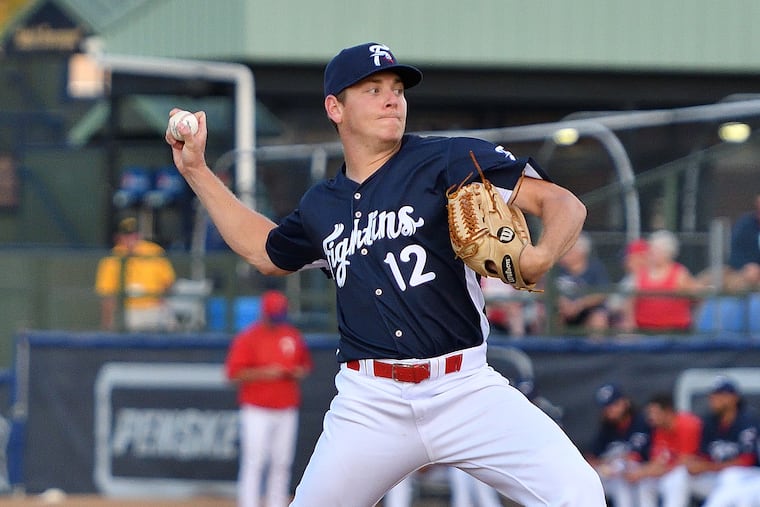Phillies pitching prospect Spencer Howard is critical to new manager Joe Girardi’s chances of success | Scott Lauber
Although Joe Girardi’s first Phillies rotation figures to look different from Gabe Kapler’s last, it will be just as thirsty for homegrown help. Enter Spencer Howard.

J.T. Realmuto may be the best catcher in baseball. Aaron Nola is one of five pitchers to rack up 200 strikeouts and 200 innings in each of the last two seasons. And Bryce Harper is owed a total of $310 million through 2031.
But the most important player in the Phillies organization that manager Joe Girardi just joined is a 23-year-old right-hander who has not yet competed above double A.
Spencer Howard wrapped up his season Thursday night with three more scoreless innings in an Arizona Fall League start. In 89⅓ innings between the minors and the fall league, he allowed 53 hits, posted a 2.12 earned-run average, and had a 117-to-25 strikeouts-to-walks ratio.
“He’s really close [to being ready for the big leagues] and has a chance to be impactful,” a rival scout said Friday after watching Howard in Arizona. “He’s one of the top three or four pitching prospects I’ve seen.”
For the Phillies, it’s imperative that Howard turns into a solid big-league starter. His success is central, in fact, to their return to contention.
Over the last four seasons, only five homegrown pitchers (Nola, Cole Irvin, Drew Anderson, Mark Leiter Jr., and Ranger Suarez) have made a start for the Phillies, an indictment of the talent in the organization when general manager Matt Klentak arrived and the quality of the players whom he has added. With the possible exception of Zach Eflin, even the young pitchers acquired in trades during the Phillies’ rebuilding -- Ben Lively, Nick Pivetta, Jerad Eickhoff, Jake Thompson, Vince Velasquez, Enyel De Los Santos, etc. -- haven’t proven to be consistent pieces of a contending team’s rotation.
Drafting and developing young, cost-controlled pitching is the silver bullet to long-term success. It saves an organization from spending big money on free-agent pitchers with tread on their elbows and shoulders. Growing arms and buying bats is unquestionably the most sensible roster-building strategy.
That’s why Howard’s development is paramount.
“Just being around him every day and seeing where he came from, the growth that I’ve seen over the last couple years with him, it’s been tremendous,” Phillies minor-league pitching coach Brad Bergesen said recently. “You’ve always seen the potential, but just this last year, I think he’s finally starting to put it all together. It’s been a fun process to watch and to be able to be a part of.”
A 2017 second-round draft pick, Howard began the 2018 season with a 5.64 ERA, 19 walks, and 66 strikeouts in 52⅔ innings through 12 starts at low-A Lakewood. After that, though, he went on an 11-start run in which he notched a 2.12 ERA, 21 walks, and 81 strikeouts in 59⅓ innings.
Bergesen, a former big-league pitcher who worked with Howard in Lakewood and this year at high-A Clearwater, said the difference was twofold. Not only did Howard refine his off-speed pitches, notably a changeup that comes out like his upper-90s fastball but is at least 15-mph slower, but he also learned how to use them without eliminating the ones that don’t feel as effective in a particular outing.
“He’s got four-plus pitches,” Bergesen said, noting the fastball, changeup, slider, and curveball. “Every game [in 2018] he would have a couple and then maybe the other two weren’t working, so he put them in his back pocket. This year, a curveball might pop out the first couple times and he’s not just getting away from it. He’s able to make an adjustment and carry out that four-pitch repertoire game to game.”
Howard got everyone’s attention with a 103-pitch no-hitter in a playoff start last year for Lakewood. He began this season with four strong starts for Clearwater, but he missed the next two months with a shoulder strain. Upon his return in July, he tossed 15 scoreless innings over three starts and got promoted to double-A Reading, where he posted a 2.35 ERA in six starts.
With another chance to pitch in the postseason, Howard took a no-hitter into the sixth inning against Trenton on Sept. 4. Bergesen, monitoring the game on his phone, phoned Phillies minor-league pitching coordinator Rafael Chavez to ask, “How far can we take this?”
Howard gave up a one-out single in the sixth, sparing the Phillies a potentially difficult decision. He completed seven innings on 99 pitches, allowed one run on two hits, and struck out 12.
“He’s had a couple of his best outings of his career in big games, big situations,” Bergesen said. “Even though it’s low-A and double-A, big games are big games. If you have a guy that’s able to take it to the next level in those types of situations, that’s very promising.”
The Phillies had a few conversations about calling up Howard for a September playoff drive. Ultimately, it was a passing fancy.
“I thought he could have helped them in September,” an NL scout said this past week. “But I understood if they were cautious because he did have [injured list] time.”
Regardless, it’s worth wondering how quickly Howard can join the Phillies next season. Barring a lights-out spring training, he figures to open the season in triple A. Before long, though, he could be plugged into Girardi’s first Phillies rotation, which figures to look different from Gabe Kapler’s last but will be just as thirsty for homegrown help.
“That’s definitely above my pay grade, but what I can say is he’s got tremendous talent,” Bergesen said. “The sky’s the limit for him, in my opinion.”